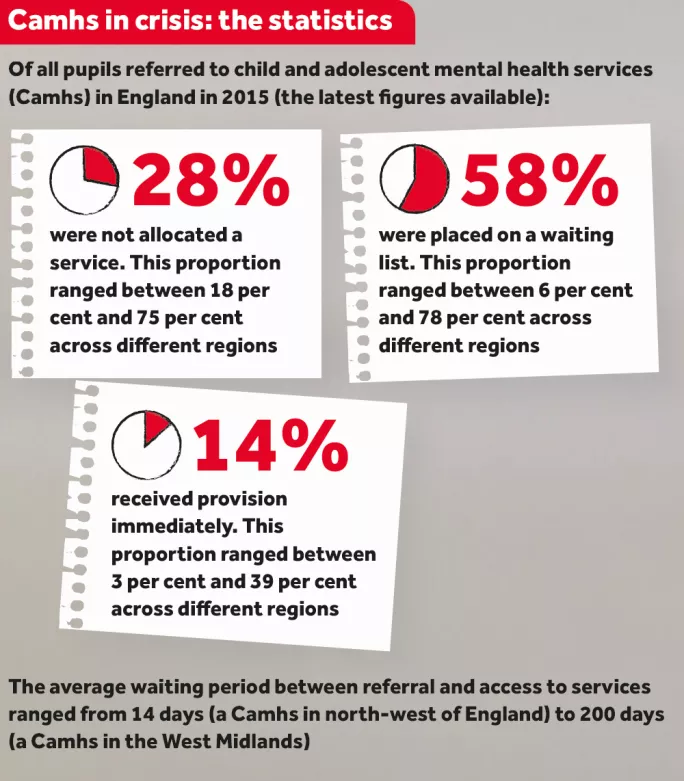Pupils risking their lives as Camhs support collapses

The notification came to Rebecca Beatty’s office: one of her pupils had attempted suicide, and was in hospital.
Days later, Beatty*, head of a secondary in south-west England, spoke to the girl about what had happened. “How were you feeling at the time?” Beatty asked.
“Pretty awful,” the girl replied. But, although she had taken an overdose, the pupil revealed that it had not been an attempt to kill herself.
She had simply realised that this was the step she needed to take in order to be seen by child and adolescent mental health services (Camhs).
Funding cuts to the service had made the thresholds for treatment so high that the pupil felt this highly risky tactic was her only option.
Tes has established that she is one of many. Stretched health resources are driving growing numbers of pupils to make what look like suicide attempts just so they can have their mental illness treated.
In Beatty’s school alone, three pupils have made apparent suicide attempts to ensure that they would be seen by Camhs professionals.
‘Escalating’ behaviours
Papyrus, the teen-suicide prevention charity, says that it is common for helpline advisers to hear from pupils who feel that they have to express suicidal intentions - or make suicide attempts - in order to be seen by Camhs.
“People either can’t access Camhs or aren’t getting enough from them,” says Heather Dickinson, who works for the charity.
“Sometimes young people who feel that they’re not taken as seriously by Camhs as they might be - they feel that they’re expressing how they feel, and that’s not being picked up enough. So they will escalate their behaviours.”
She has seen a dramatic increase in the number of calls and text messages the charity receives from teenagers expressing suicidal thoughts following their inability to access Camhs. “Young people are feeling quite desperate,” Dickinson says. “They’re saying, ‘I’ve taken steps to make a suicide attempt, to let people know how bad I’m feeling.’”
Anna Cole, inclusion specialist for the Association of School and College Leaders, is “absolutely disgusted and horrified” by the idea that pupils might be forced to attempt suicide in order to access Camhs.
But she says that it is relatively common for heads to take pupils to accident and emergency because they have been unable to access mental health support elsewhere. “There comes a point when somebody needs specialist support, and schools cannot do that,” she adds.

Referring to her pupils’ suicide attempts, Beatty says: “I don’t think there’s anyone who genuinely wanted to end it all. They wanted to get help, and the only way they could explain that was through their actions.
“It wasn’t that people weren’t listening to them - people had put in referrals to Camhs. But the threshold for getting some kind of help is very difficult. Camhs can only deal with the most acute cases.”
A crisis in mental health services for children and teenagers has been building for some time. Chronic funding shortages mean that teachers are unable to access support for pupils in need.
Last year, 61 per cent of teachers polled by children’s mental health charity the Anna Freud Centre said that lack of capacity was “very much” a barrier to supporting pupils.
And a survey conducted by the Office of the Children’s Commissioner showed that, of all pupils referred to Camhs in 2015 (the latest figures available), only 14 per cent were able to access the service immediately.
Meanwhile, 28 per cent of those referred were not allocated a service at all. In some areas, this figure was as high as 75 per cent.
Camhs thresholds are “sky high”, according to Sue Parkes, deputy head at Fairfield Endowed Junior School, in Buxton, Derbyshire. “Schools are basically being told to support vulnerable kids on their own,” she says.
Her school has resorted to paying for private educational psychologist referrals “as when I tried to buy additional sessions from [the local authority] I was told there was no capacity”.
‘Problems escalate’
Mary Bousted, general secretary of the ATL teaching union, says: “This just shows the desperate straits that many children and young people are in. They’re seriously mentally ill, and they simply cannot access help.”
Tom Madders, of mental health charity YoungMinds, says: “Far too many are waiting months for specialist treatment, or being turned away because the threshold for services is so high. The lack of support all too often means that problems escalate and become more complex.”
Dickinson adds that even pupils’ attempts to kill themselves do not guarantee that they will be seen by Camhs. “We’ve had lots of concerned parents calling us, saying that young people have made suicide attempts, and sometimes are coming home from hospital and they still can’t get access to Camhs,” she says.
“On occasion, we’ve had ward staff calling up saying they’re unsure what to do with the young person, because they’re still expressing suicidal thoughts and they can’t access Camhs.”
A Conservative Party spokesman said: “The prime minister has described any lack of mental health support as a burning injustice - and we have an ambitious programme of reform to improve care.
“We’re putting £1.4 billion more into children’s mental health services and establishing the first waiting time standards for treatment. Our manifesto commits to better, more responsive Camhs treatment. If elected, this will be an urgent priority.”
*The headteacher’s name has been changed to protect her pupils
You need a Tes subscription to read this article
Subscribe now to read this article and get other subscriber-only content:
- Unlimited access to all Tes magazine content
- Exclusive subscriber-only stories
- Award-winning email newsletters
Already a subscriber? Log in
You need a subscription to read this article
Subscribe now to read this article and get other subscriber-only content, including:
- Unlimited access to all Tes magazine content
- Exclusive subscriber-only stories
- Award-winning email newsletters